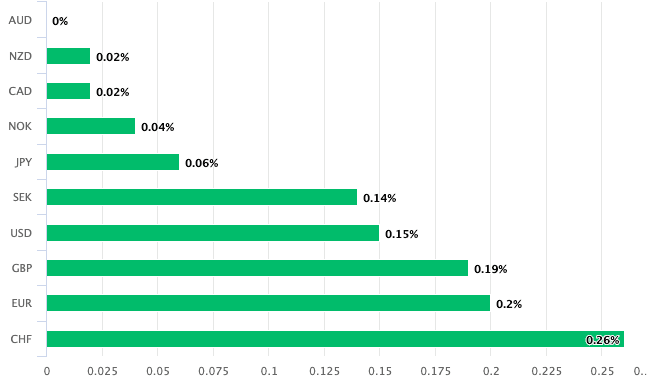Australian Dollar Outperforms on Rising China Stimulus Bets
- Written by: Gary Howes
-

Image © Adobe Stock
The Australian Dollar is the day's best-performing major currency amidst rising bets that Chinese authorities will boost stimulus initiatives following a dour set of inflation prints.
The Aussie advanced against all G10 peers, closely followed by fellow commodity currencies the Canadian and New Zealand Dollars, after China reported CPI inflation fell 0.3% year-on-year in December.
Inflation rose 0.1% month-on-month in December, undershooting expectations for 0.2% growth. The figures underscore the continued lacklustre performance of the world's second-largest economy and Australia's primary export destination.
At face value, this data should be a negative for the Australian Dollar, which is considered a liquid proxy for exposure to China, but investors are already looking forward to how it could elicit a pro-growth response from authorities.
"China's CPI and PPI continue to face deflationary pressures in the near term. With China's economic growth outlook remaining weak, policymakers are now expected to increase support," says Ho Woei Chen, Economist at United Overseas Bank.
PPI inflation, which is particularly important to China given the size of the country's manufacturing base, shrank 2.7%, which was more than the -2.6% the market expected.
Authorities will be under pressure to boost output ahead of the National People’s Congress (NPC), which is due in March.
UOB expects interest rate cuts to be announced, as well as cuts to banks’ reserve requirement ratio (RRR).

Above: AUD outperformed all peers on Jan 12. Track AUD with your custom rate alerts. Set Up Here.
A further boost to market liquidity could also be provided, according to Chen: "the urgency for policy action is seen in the weak property market response to the stronger measures while the official GDP growth target for 2024 may be set higher than consensus' forecast to boost confidence."
The People’s Bank of China (PBOC) recently signalled that monetary policy would be further eased to provide “strong” support for reasonable credit growth.
A consensus of economists predicts a 10 bps cut to the 1Y medium-term lending facility (MLF) to 2.40% next Monday, as well as a possible reduction in banks’ reserve requirement ratio (RRR) within the quarter.
A credible policy response can boost sentiment towards China, in turn boosting the Australian Dollar, which has stuttered at the start of 2024.
Separate data out of China Friday showed aggregate financing from the country's banks fell to RMB1,945B in December from a revised RMB2,455B in November. Consensus expected stronger RMB2,162B.
New yuan loans dropped to RMB1,170B in December from a revised RMB1,088B in November; the consensus was RMB1,350B.
M2 growth slowed to 9.7% y/y in December from 10.0% in November. Consensus was 10.1%. M1 growth was flat at 1.3% in December. Consensus was 1.5%.
These figures will only add to expectations that authorities will ease credit costs to boost lending in an attempt to reinvigorate the economy.
"The PBoC is likely to cut the one-year MLF rate by 10bp on Monday, following coordinated bank deposit rate reductions over the last month. An RRR cut is not out of the question, but probably will be left until Q2, so that easing is phased," says Duncan Wrigley, Chief China+ Economist at Pantheon Macroeconomics.











